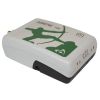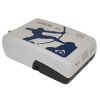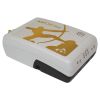Eos Bridge Bluetooth Connector
The Eos Bridge is a palm-sized Bluetooth connector that makes any third-party instrument Bluetooth compatible with iOS, Android or Windows devices.
Features
- Transforms legacy Bluetooth instruments into iOS-compatible devices
- Converts non-Bluetooth instruments into iOS-compatible devices via serial port
- Rechargeable Li-Ion battery using standard USB connection
- Free ground shipping
- Expedited repair and warranty service
- Lifetime technical support
- More
The Eos Bridge is a palm-sized Bluetooth connector that makes any third-party instrument or sensor, such as a laser rangefinder, Bluetooth compatible with iOS, Android or Windows devices. This allows you to combine the power of survey-grade mapping from Arrow Series GNSS receivers, GIS apps and professional measurements from third-party instruments and sensors.
Convenient, Portable and Rugged
With its long-lasting battery, the Eos Bridge delivers days of continuous use on a single charge. And thanks to its lightweight design, the Eos Bridge can easily be stored in a pocket, clipped to a belt, or attached directly to any instrument. The Eos Bridge is also rugged and waterproof, so you can confidently take it to the harshest environments.
Connect with Legacy-Bluetooth Instruments
Have you ever wished your existing laser rangefinder, utility locator — or any other sensor — would automatically send data to your mobile mapping solution? The days of wishing are over. With the Eos Bridge, simply pair any legacy instrument to your iOS device (while connected to an Arrow GNSS receiver), and the Eos Bridge takes care of the rest. Measurements from your professional instruments will flow directly to iOS, where you can capture them in a GIS app with high-accuracy locations from your Arrow GNSS receiver.
Connect with Serial Port
No legacy Bluetooth module? No problem. Instruments and sensors can also connect to the Eos Bridge via a serial port to achieve the same results. Choose this option to use the Eos Bridge with not only iOS devices, but also Android and Windows smartphones and tablets.
- Eos Bridge
- Integrated Li-Ion Battery
- USB Charger
- Belt Clip
- Strap Loop
In The News
Science for Science’s Sake: Monitoring Ocean Energy Availability and Gulf Stream Dynamics
Scientific research often begins with a question, sometimes driven by a specific goal or application, but many scientists believe in science for science’s sake. Marine environments and physical dynamics like the Gulf Stream are popular fields of research due to their complexity and importance, presenting a unique opportunity to learn more about previously unexplored phenomena. Environmental researchers, in particular, see the value in these ecosystems, but many also grew up with a passion for the natural world, and choosing a field that allows them to interact with and learn about the environment around us is an easy choice.
Read MoreResearch in the Reserve: Promoting Interdisciplinary Conservation at the Great Bay National Estuarine Research Reserve
On an early winter day in 1973, a helicopter buzzed over Durham, New Hampshire, just a few miles from the Atlantic Ocean. One of the helicopter’s guests, oil magnate Aristotle Onassis, owner of Olympic Refining, looked east of town and saw what he hoped would become the world’s largest oil refinery. Instead, he saw the Great Bay; thousands of acres of green coastal forest, mud flats, salt marshes, and estuarine tidal waters stretching over the land toward New Hampshire's small Eastern coastline. Onassis likely also saw a group of Durham residents staked out on the bay’s coast, ready for him to pass overhead. While out of place in the natural setting, an obvious message was spelled out in red paper: “Not Here.
Read MoreFloating Global New Ideas: Buoy-Enabled Research at Florida Agricultural and Mechanical University’s School of the Environment
Florida Agricultural and Mechanical University (FAMU), based in Tallahassee, Florida, is the highest-rated public Historically Black College or University in the United States. FAMU’s School of the Environment (FAMU-SOE) offers BS and BA degrees in Environmental Studies, and BS, MS, and Ph.D. degrees in Environmental Science, with specialisms available in areas including Environmental Policy and Risk Management, Aquatic and Terrestrial Ecology, and Biomolecular Sciences. In 2021, FAMU-SOE deployed a NexSens CB-450 buoy in Apalachee Bay, a key oyster farming area around 30 miles south of Tallahassee. The buoy has quickly been incorporated into the curriculum, providing environmental insights for student research, the community, and beyond. Dr.
Read More










